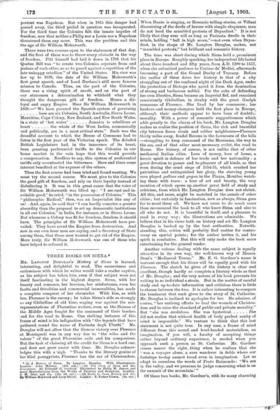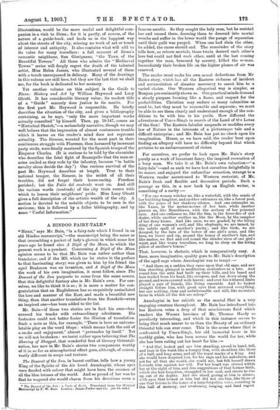THREE BOOKS ON SIENA.*
Ma. LANGTON DOUGLAS'S Hiskiy of Siena is learned, interesting, and delightful to read. The earnestness and enthusiasm with which be writes would take a reader captive, as his subject has taken him, even if that subject were not itself, fascinating in the highest .degree. Siena, with her beauty and romance, her heroism, her misfortunes, even her faults and frivolities and commercial immoralities, has made a complete conquest of her chronicler. With him, as with her, Florence is the enemy ; he takes Siena's side as strongly as any Ghibelline of old time, waging war against the mis- representations of Florentine writers, even as the Sienese of the Middle Ages fought for the command of their borders and for the road to Rome. One striking instance of this frame of mind is his indignation with "the legends that have gathered, round the name of Farinata degli Uberti." Mr. Douglas will not allow that the Sienese victory over Florence at Montaperti was in any way due to "the wiles and the valour" of the great Florentine exile and his companions. But the task of claiming all the credit for Siena is a hard one, and does not grow easier with time. Mr. Douglas acknow- ledges this with a 'sigh. "Thanks to the literary genius of her filial panegyrists, Florence has the ear of Christendom.
• (1.) A • History of Siena. By Langton Douglas. With Illustrations. London: John Murray. [258. not.]—(2) The Story of Siena and San Ginuitnano. By'lldmund G. Gardner. Illustrated by Helen M. James, and many_Beproductions from the Works of Painters and Sculptors. London: J. M. Dent and Co. [10s. 6d. net.1—(3) Guide to Siena History and Art. By William Heywood and Lucy Olcott. London: T. Fisher Unwiu. [6s. net]
When Dante is singing, or Boccacio telling stories, or
discoursinief the deeds of heroes with simple eloquence, men" do not heed 'the mtinibled protests of Dryasdust." It is'not likely that they, ever will as long as Farinata dwells in their' minds, holding "hell in high scorn,"---not even when Dryas; dust, in the shape Of Mr. Langton Douglas, makes, not" "mumbled protest," but brilliant and romantic history.
The time was short during which Siena held a . prominent place in Europe. Roughly speaking, her independent life lasted about three hundred and fifty years, from A.D. 1200 to 1557, when she submitted perforce to.Cosimo de' Medici, afterwards becoming a part of the Grand Duchy of Tuscany. Before the earlier of these dates her history is that of a city struggling out of the confused night of the Dark Ages, under the protection of Bishops' who saved it from the domination of strong and barbarous noble2. For the sake of defending her own liberties, Siena became an Imperial fief, and remained consistently Ghibelline, in rivalry with the great Guelph commune of Florence.. She lived by her commerce ; her bankers and money-changers held the first place in Europe, although their methods appear to have been of doubtful morality. With a power of romantic suggestiveness which adds greatly to the charm of his book, Mr. Langton Douglas makes us realise the position of Siena, the rich and beautiful city between fierce rivals and robber neighbours—Florence thirty miles away, feudal Barons in the fastnesses of the hills —struggling to keep command of the Maremma, the way to the sea, and of that other most necessary outlet, the road to Rome. Her history, of course, is not unlike that of other mediaeval Italian cities. Love of money, love of home, a heroic spirit in defence of her trade and her nationality : a great devotion to games and to pleasure of all kinds, so that even during the cruel siege of 1554-55, which crushed her patriotism and extinguished her glory, the starving young men played pallone and pugna in the Piazza, Montluc watch- ing them with tears : a -love of art and beauty, the very mention of which opens up another great field of study and criticism, from which Mr. Langton Douglas does not shrink. All this, and more, might be matched in the annals of other cities ; but certainly in fascination, now as always, Siena goes far to excel them all. We have not room to do much more than recommend the book to all who know Siena and also to all who do not. It is beautiful in itself, and a pleasure to read in every way ; the illustrations are admirable. We believe that in his views both on history and art Mr. Langton Douglas is backed up by the best authorities. Notwith- standing this, critics wil1 probably find matter for contro- versy on special points ; for .the author invites it, and his spirit is combative. But this will only make the book more entertaining for the general reader.
Another volume dealing with the, same subject is equally attractive in its own way, the well-known way of Messrs. Dent's "Mediaeval Towns." Mr. E. G. Gardner's name is warrant enough that his Siena will be equally good with his Florence. The sketch he gives of the history is clear and excellent, though hardly so complete a literary whole as that of Mr. Douglas ; and the very nature of his book prevents his writing in so individual a strain. But in the matter of careful study and up-to-date information and criticism there is little to choose between the two. It is rather interesting to compare the treatment that each gives to the story of St. Catherine. Mr. Douglas is inclined to apologise for her. He admires, of course, "her untiring efforts to heal the wounds of Christen- dom and to raise the standard of public and private morality."
But "she was credulous. She was hysterical . She did not realise that without health of body perfect sanity of mind is impossible.", _We, venture to think that this last statement is not quite true. In any case, a frame of mind different from this sound and level-headed materialism, an imagination, if you will, a faculty of accepting . things rather beyond ordinary, experience, is needed when . you approach such a person as St. Catherine. Mr. Gardner conies nearer the right,.thing when he realises that she " was a voyager alone, a sure wanderer in fields where our footsteps to-day cannot tread. even in imagination. Let us adapt to ourselves the words of Irate Raimondo : We are in the valley, and We presume to judge concerning what is on the summit of the mountain."
Of these two books, Mr. Gardner's', with its many charming illustrations, would be the more useful and delightful com- panion in a visit to Siena; for it is partly, of course, of the nature, of a guide-book, and leads us in the happiest way about the streets of the city, missing no work of art or touch of interest and antiquity. It also contains what will add to its value for many travellers : a full account of Siena's romantic neighbour, San Gimig,nano, "the Town of the Beautiful Towers." All those who admire the "Mediaeval Towns" series will deeply regret the death of the talented artist, Miss Helen James, who illustrated several of them with a touch unsurpassed in delicacy. Many of the drawings in this volume are still hers, but they are the last that we shall see, for the book is dedicated to her memory.
Yet another volume on this subject is the Guide to Siena : History and Art by William Heywood and Lucy Olcott. It has considerable literary value ; its modest title of a " Guide " scarcely does justice to its merits. For the first part Mr. Heywood is responsible. He briefly describes the situation of the city, and gives a bibliography containing, as he says, "only the more important works actually consulted" by himself. Then, pp. 19-147, comes an "Historical Sketch,"—a melancholy narrative, though we may well believe that the impression of almost continuous trouble which it leaves on the reader's mind does not represent actuality. The Sienese, worsted for the most part in their continuous struggle with Florence, then harassed by incessant party strife, were finally mastered by the Spanish troops of the Emperor Charles. (It is curious to be told by the chronicler who describes the fatal fight of Scanag,allo that the men-at- arms smiled as they rode by the infantry, because "in battle cavalry alone decide the day.") One curious survival of the past Mr. Heywood describes at length. True to their national temper, the Sienese, in the midst of all their troubles, did not forget their horse-racing. Freedom perished; but the Polio del contrade went on. And still the various wards (contrade) of the city train racers with which to lessen their neighbours' pride. Miss Lucy Olcott gives a full description of the artistic wealth of the city. A section is devoted to the notable objects to be seen in the environs; this is followed by a fuller bibliography, and by some "Useful Information."







































 Previous page
Previous page